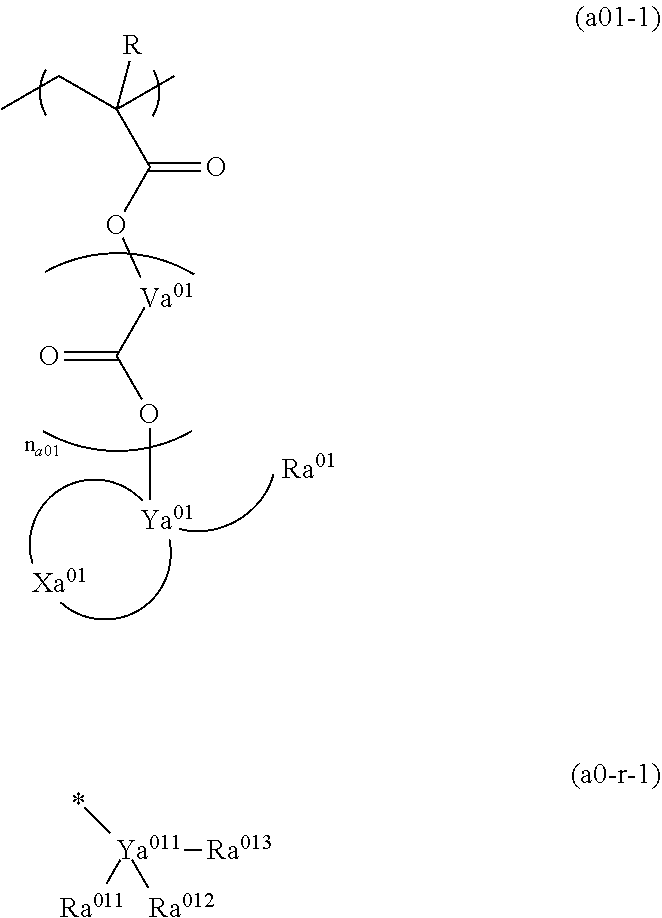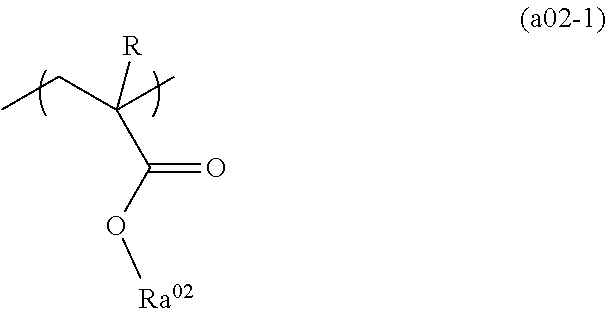Resist composition and method of forming resist pattern
a composition and resist technology, applied in the field of resist composition and resist pattern formation, can solve the problems of difficult to achieve high sensitivity and cdu with the conventional resist composition, and achieve the effect of excellent cdu
- Summary
- Abstract
- Description
- Claims
- Application Information
AI Technical Summary
Benefits of technology
Problems solved by technology
Method used
Image
Examples
synthesis example 1
[0634][Synthesis of Polymer Compound (A-1)]
[0635]38.0 g of a monomer (a01-1-1), 59.6 g of a monomer (a02-1-1), and 9.1 g of azobis (isobutyric acid) dimethyl (V-601) as a polymerization initiator was dissolved in 195 g of methyl ethyl ketone (MEK), heated at 85° C. in a nitrogen atmosphere, and stirred for 5 hours. Thereafter, the obtained reaction solution was precipitated in 2,710 g of heptane and washed. The obtained white solid was filtered and dried under reduced pressure overnight to obtain 30 g of a target polymer compound (A-1).
[0636]The obtained polymer compound (A-1) had the standard polystyrene-equivalent weight-average molecular weight (Mw) of 10,500, which was determined by GPC measurement, and the polydispersity (Mw / Mn) of 1.52. The copolymerization compositional ratio (the ratio (molar ratio) between constitutional units in the structural formula) determined by 13C-NMR was l / m=55 / 45.
synthesis examples 2 to 18
[0637]In the same manner, polymer compounds (A-2) to (A-18) having the compositional ratios shown in Table 1 were synthesized using compounds shown below.
[0638]With respect to the obtained polymer compounds, the copolymerization compositional ratio (ratio between constitutional units in the polymer compound (molar ratio)) of the polymer compound, which was determined by 13C-NMR, the standard polystyrene-equivalent weight-average molecular weight (Mw), which was determined by GPC measurement, and the polydispersity (Mw / Mn) are shown in Table 1.
[0639]The polymer compound (A-1) to the polymer compound (A-18) respectively obtained by the Synthesis Examples described above are shown below.
TABLE 1CopolymerizationWeight-averagePolymercompositional ratio (molar ratio)molecular weightPolydispersitycompoundof polymer compound(Mw)(Mw / Mn)Synthesis(A-1) (a01-1-1) / (a02-1-1) = 55 / 4510,5001.52Example 1Synthesis(A-2) (a01-1-1) / (a02-1-1) = 70 / 3012,6001.56Example 2Synthesis(A-3) (a01-1-1) / (a02-1-1) = ...
PUM
| Property | Measurement | Unit |
|---|---|---|
| temperature | aaaaa | aaaaa |
| boiling point | aaaaa | aaaaa |
| boiling point | aaaaa | aaaaa |
Abstract
Description
Claims
Application Information
 Login to View More
Login to View More - R&D
- Intellectual Property
- Life Sciences
- Materials
- Tech Scout
- Unparalleled Data Quality
- Higher Quality Content
- 60% Fewer Hallucinations
Browse by: Latest US Patents, China's latest patents, Technical Efficacy Thesaurus, Application Domain, Technology Topic, Popular Technical Reports.
© 2025 PatSnap. All rights reserved.Legal|Privacy policy|Modern Slavery Act Transparency Statement|Sitemap|About US| Contact US: help@patsnap.com



